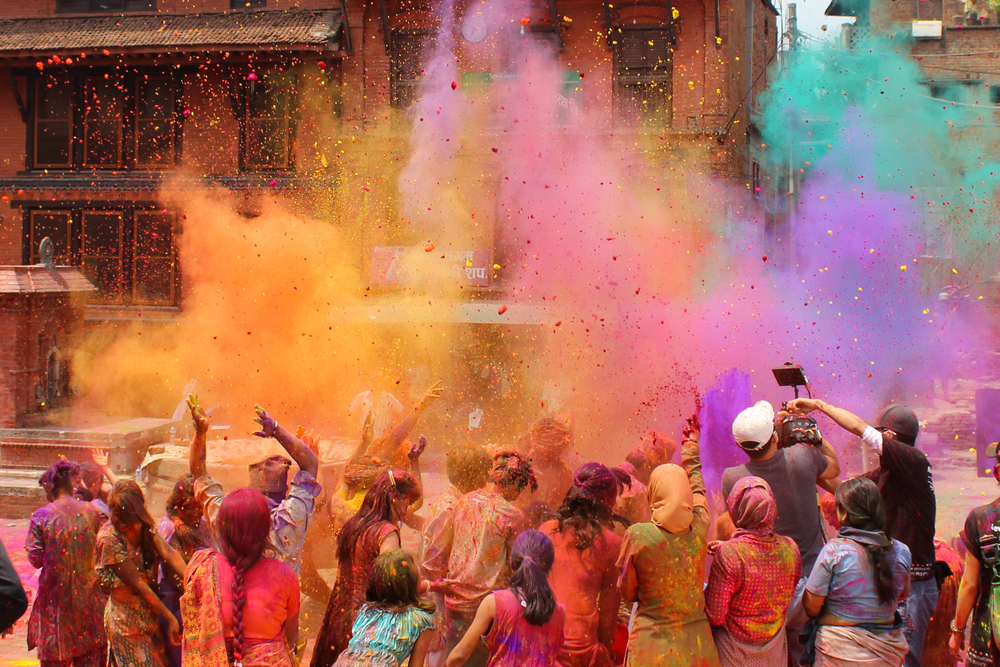Holi, the vibrant “Festival of Colors,” explodes onto the scene every year, transforming streets into kaleidoscopes of joy and laughter. But beyond the playful throws of colored powder lies a rich tapestry of cultural significance, making Holi a celebration that transcends mere revelry. Let’s delve into the multifaceted reasons why celebrate Holi festival and explore the magic it weaves.
1. Welcoming Spring and New Beginnings:
As the harshness of winter fades and spring paints the world in hues of renewal, Holi marks the beginning of the Indian summer. It signifies a time of rebirth, a chance to shed the old and embrace the new. Just like nature awakens from its slumber, Holi encourages us to shed the baggage of negativity and step into a fresh chapter with open hearts and renewed hope.
2. Commemorating the Triumph of Good over Evil:
Holi’s legend is deeply rooted in the epic tale of Hiranyakashipu, a demon king who believed himself invincible. His son, Prahlad, remained steadfast in his devotion to Lord Vishnu. Enraged by this defiance, Hiranyakashipu plotted to kill Prahlad. Vishnu, in the form of Narasimha, a half-man, half-lion, emerged from a pillar and vanquished the evil king, signifying the ultimate victory of good over evil. Holi celebrates this triumph, reminding us that even in the darkest of times, light will always prevail.
3. Celebrating Divine Love:
Holi also commemorates the eternal love story of Radha and Krishna, two Hindu deities known for their unwavering devotion to each other. The playful throwing of colors symbolizes the playful love they shared, reminding us of the importance of love, compassion, and acceptance in our own lives.
4. Strengthening Social Bonds and Forgiveness:
Holi transcends religious and social boundaries, bringing people together in a spirit of camaraderie and community. During this festival, old grudges are forgotten, and new relationships are fostered. The atmosphere is one of forgiveness and acceptance, as people shower each other with colors, breaking down social barriers and fostering a sense of unity.
5. Embracing the Spirit of Merriment and Playfulness:
Holi is a time to let loose, shed inhibitions, and embrace the carefree spirit of childhood. The playful throwing of colors transcends age and social status, creating a joyous and inclusive atmosphere. This shared experience strengthens social bonds and fosters a sense of belonging.
6. A Feast for the Senses:
Holi is not just a visual spectacle; it’s a feast for all senses. Traditional delicacies like Gujiya (sweet dumplings) and Thandai (a refreshing drink) tantalize the taste buds. The vibrant colors, lively music, and infectious laughter create an unforgettable sensory experience that stays with you long after the festivities end.
7. A Celebration of Life and Cultural Heritage:
Holi is a vibrant expression of Indian culture and heritage. It’s a time to connect with one’s roots, learn about traditions, and share stories with loved ones. The festival transcends religious boundaries, offering a glimpse into the rich tapestry of Indian culture and traditions.
Celebrating Holi Beyond Borders:
Holi has transcended its geographical and religious origins and is now celebrated by people of diverse backgrounds across the globe. It serves as a powerful reminder that joy, love, and the celebration of life can unite us all, regardless of our differences.
So, the next time you witness the vibrant colors of Holi, remember that it’s not just a playful festival; it’s a celebration of life, love, new beginnings, and the enduring spirit of good over evil. It’s an invitation to embrace joy, connect with your community, and create lasting memories.
FAQs:
- Why is Holi celebrated?
Holi is celebrated for several reasons, including:
- Welcome to spring and the end of winter.
- Commemorating the victory of good over evil, as depicted in the story of Hiranyakashipu and Prahlad.
- Honoring the divine love of Radha and Krishna.
- Marking a new beginning and letting go of past grievances.
- Strengthening social bonds and fostering community spirit.
- What is the significance of colors in Holi?
The vibrant colors thrown during Holi symbolize joy, spring, and the triumph of good over evil. Each color has its own meaning, such as red for love and sacrifice, green for new beginnings, and blue for the cosmic ocean.
- Who celebrates Holi?
Holi is primarily a Hindu festival, but it is also enjoyed by people of other faiths and backgrounds. The festival has spread beyond India and is now celebrated by the Indian diaspora in various parts of the world, making it a truly global celebration.
- What are the traditions associated with Holi?
Holi festivities typically involve:
- Lighting a bonfire on the eve of Holi, symbolizing the burning of negativity.
- Throwing colored powders and water on each other, creating a joyous and colorful atmosphere.
- Singing, dancing, and feasting with family and friends.
- Exchanging sweets and greetings, spreading goodwill and strengthening social bonds.
- Is there anything special I should know before celebrating Holi?
It’s important to be respectful of the cultural significance of Holi and to participate in the festivities with a spirit of joy and inclusivity. Be mindful of using natural, eco-friendly colors and avoid throwing them at people who may not want to participate.

